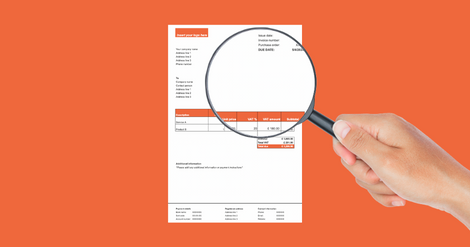In the bustling world of freelancers, small business owners, startups, and established businesses, time is a precious commodity. Billing clients should not add to your workload; it should be simple, fast, and professional.
This is where an effective invoice template becomes your silent ally.
Knowing why a good invoice is key to your business practice and understanding what to include in it are essential steps toward getting paid promptly and maintaining a stellar reputation with your clients.
In this article, we will explore the ins and outs of how to write an invoice and how Chaser's free invoice template can make this process a breeze.
Why is a good invoice important for your business?
An invoice is more than just a document requesting payment; it's also your official record of services provided to your clients. It serves as proof of the work completed, terms agreed upon, and a reminder for the client to settle their outstanding balance.
A well-crafted invoice can also enhance your professional image and build trust with your clients by showcasing your attention to detail and organization.
Moreover, having a streamlined invoicing process saves you time and effort, allowing you to focus on growing your business and delivering quality services.
Sending a good invoice is akin to dressing for success. It not only reflects your professionalism and attention to detail but also reinforces the reliability and credibility of your brand. Your invoice serves as the final impression of your service or product delivery; hence, it's crucial to make it count.
With a well-developed invoice, you accomplish two vital business chores: ensuring a seamless payment process and maintaining organized financial records.
A clear, well-structured invoice paves the way for hassle-free payments and contributes to smoother cash flow management, which is the lifeline of any business, big or small. Given the current late payments crisis, businesses need to implement all possible measures to ensure timely payments, and a good invoice is your first line of defense against this issue.
Communicating your brand
Your invoice is an extension of your brand. It's the visual representation of your business and, therefore, should be consistent with your branding elements, such as logo, colors, fonts, and overall aesthetic.
Consistency in branding helps to build brand recognition and recall, reinforcing your identity in the minds of clients. Branding also adds a professional touch to your invoice and sets you apart from competitors.
How to write an invoice like a pro
Creating an invoice can seem daunting, but it doesn't have to be. Our free invoice template allows you to easily create professional-looking invoices in no time. The template is customizable and includes all the essential elements for a well-crafted invoice. Learning how to write an invoice is simpler when you have a template to guide you.
There are several key components every invoice should contain to perform its function effectively:
- Your business details: This includes your logo, business name, contact details, and, if applicable, your Tax Identification Number. This is not just branding; it also makes it easy for clients to contact you for repeat business or queries.
- Client's information: Just as you have identified yourself, ensure your invoice identifies the recipient clearly by including their name, address, and other relevant details.
- Invoice number: Unique invoice numbers are crucial for tracking payments and managing your accounts.
- Invoice date of issue: Always include the date the invoice issue date and the payment due date.
- Detailed description of goods or services: Specify what the invoice is for, breaking down services or products provided with quantities and costs.
- Total amount due: Outline clear and correct calculations, including any applicable sales tax, discounts, or additional fees.
- Payment terms: Outline accepted payment methods and any other payment details, such as late fees or early payment discounts.
- Personalized note: A small thank you or a courtesy message can enhance client relationships.
Utilize Bold and Italicized text where necessary to enhance readability and draw attention to the most essential invoice details, such as the total amount due and due date. Keeping your invoice visually appealing and easy to read is essential for prompt payments.
Let's take a look at each of these elements in more detail to understand how to write an invoice. Whether you're using an online invoice generator or you choose to create invoices from scratch, it's important to know why and how to include each section on your invoices.
Business details
Your business details are one of the key elements you will need when writing an invoice. Without them, your customer won't know who the invoice is from or what it's regarding. The basics such as your company name and contact details (business owner, business address, etc.) enable clients to quickly respond to invoices when they receive them. Additional branding such as your company logo will also help to make your invoice more memorable.
Customer information
Of course, your client wants to know that the invoice is definitely intended for them. Including the client's details is also a must for your own records. If you want to accurately track payments, you need to attach a client name and the customer's company to every invoice in addition to having a unique invoice number. When you use invoice software, it can easily save client details for you.
Invoice number
You're aware you need a numbering system for your invoices, but how should you number them? Some businesses choose to use specific methods, while others simply generate random numbers. If you're using a free invoice generator, it can create numbers for you that you can then make a record of to refer to in the future.
You could also number invoices based on date, department or other factors, or perhaps give each client their own reference to include in all their invoice numbers. Your invoice number will help you keep track of payment status and make for a professional looking invoice too.
Invoice date
The creation and supply date of your invoice is crucial because it relates to when you supplied your goods or services, as well as your payment terms. It's also much easier to keep your invoices organized if they have a clear date and it makes it easier for your clients to do the same.
If you want to invoice properly, assigning a date is one of the first things you need to do.
Description of goods or services
Just as you need to provide clients with information about when you supplied your goods or services, you also need to be clear about what they have received (or will receive). While the description should be clear, it doesn't need to be overly long. Stick to the key facts and ensure your description is concise, containing only essential information.
Where necessary, break down what you provided into subcategories to make the costs clear to the client. To invoice effectively, you need to give them a good understanding of what they agreed to pay for. Your professional invoice needs to get everyone on the same page.
Total amount due
Make it easy for the client to quickly find the full amount they need to pay. While it's useful to provide additional details on costs, sometimes they simply want to find the key number. Include what the client owes in total on a separate line and highlight it so someone scanning the invoice will see it. You might put it in bold or make the text bigger, for example.
In addition to the final amount, don't forget to include details of how it was calculated and what it includes. If it's a VAT invoice, provide the pre-tax and post-tax amounts.
Payment terms
How clear you are with your payment terms and methods can make all the difference if you want to be paid faster. Letting the client know both when you expect payment and your accepted payment options helps to expedite payment because it makes it easier for clients.
Some common invoice payment terms include when the client needs to pay relative to when they received the goods or services, late fees that are charged if they don't pay on time, and the currency you wish to be paid in.
Be sure to include payment information, including how your client can make a bank transfer with details of your bank account, or other payment methods they can use. There are a number of payment method choices you could offer. You might give them the option to pay online or even the option of a payment plan.
Consider how to make it easier for your company to accept payment while allowing clients to use the payment method of their choice. Clear payment terms put you in the best position when it's time to request payment
While it's crucial to include the relevant details in your professional invoice, it's also crucial to keep it concise and avoid clutter. Our invoice template does this by providing a clean and organized layout.
Options for creating invoices
You can use a number of tools and methods to create a standard invoice. There are also tools that make it easier to send professional invoices to your clients. When you're exploring how to write an invoice, choosing the right tool can really affect how professional your invoices are and how efficient you can be.
Creating each invoice manually is one option. You can use a word processor like Google Docs or a spreadsheet tool like Google Sheets to draw up your invoices. This can work for a small business owner who doesn't need to send a large volume of invoices. However, as you take on more customers and need to send more invoices, you can find you need other tools to manage invoices and other documents.
Automation makes it much easier to create and send invoices. When you use templates, you can cut down on the amount of work required to create professional templates too. This leaves you with more time to focus on ensuring you can collect payment. Once you have set up templates to use for different invoice types, ensuring your invoice includes all necessary business information, you won't have to worry about it again.
Accounting software usually includes useful tools for creating and sending invoices. Integrating your accounting software with other tools can make managing invoices and payments simpler too.
When should you send your invoice?
Now that you know how to write an invoice, you need to know when to send them. To streamline your billing process, it's essential to send invoices promptly and consistently. A general rule of thumb is to invoice as soon as the service has been provided or products delivered.
Another best practice is to send recurring invoices at a set time each month for consistent services, such as retainers or subscriptions. This not only saves you time but also helps your clients plan their budget and payments accordingly.
Below are some tips to keep in mind when sending out invoices:
- Be prompt: Send your invoice promptly after the service has been provided or products delivered. This ensures the client is aware of their outstanding balance and can make necessary payment arrangements.
- Be consistent: Establish a regular billing schedule for recurring services to avoid confusion and ensure timely payments. By setting expectations, you can build trust with your clients and maintain a positive relationship.
- Be organized: Keep track of your invoicing process by using an invoice tracker or setting reminders for due dates. This will help you stay on top of your accounts and avoid any missed payments. Accounting software can also be used to streamline and automate your invoicing process.
- Be clear: Ensure all details on the invoice are clearly stated, including payment terms and any additional fees or discounts. This avoids misunderstandings and promotes transparency in your business transactions.
- Utilize technology: Consider using online invoicing software that allows for automated invoicing, tracking, and payment reminders. Using technology can help streamline your billing process and eliminate the need for manual invoicing.
- Follow up: If a client has not paid by the due date, send a friendly reminder to ensure prompt payment and avoid delay in your cash flow. Automation tools can also be used to send payment reminders, making the process more efficient and less time-consuming.
By following these tips, you can create professional invoices that effectively communicate your brand and promote timely payments, helping your business maintain a healthy financial record. Don't underestimate the importance of a well-designed invoice, as it can significantly impact your business's finances and overall success.
When should you chase an unpaid invoice?
Unpaid invoices can be a common issue for businesses of all sizes. It's essential to have a process in place for chasing overdue payments to avoid cash issues and maintain good relationships with clients.
Here are some best practices for managing unpaid invoices:
- Establish payment terms: Clearly outline your payment terms on your invoices, including due dates and any late fees. This sets expectations for your clients and gives you a basis for follow-up if necessary.
- Send reminders: If a client misses the payment deadline, send a friendly reminder via email or phone call. Sometimes payments can slip through the cracks, so it's always good to give a gentle nudge. We also have a template you can use for this!
- Consider incentives: Offer discounts for early payments or penalties for late payments to encourage prompt payments from clients.
- Utilize a collections agency: As a last resort, consider using a professional collections agency to help you recover unpaid invoices. They have the expertise and resources to track down overdue payments and handle any legal processes if necessary.
Remember, chasing an unpaid invoice is part of running a business, but it's essential to do so in a professional and respectful manner to maintain positive relationships with your clients. Building strong client relationships is crucial for repeat business and positive word-of-mouth recommendations. Keep clear records of when you receive payment so that you know when an invoice has been resolved and when it still needs to be chased.
Chaser's automated invoice-chasing platform can help streamline your invoicing process and improve your cash flow management. With customizable invoice templates, integrated payment options, and automated reminders, Chaser takes the hassle out of chasing unpaid invoices and allows you to focus on running your business.
Leveraging our free invoice template for your business needs
So, why choose our invoice template? We've designed it with a balanced focus on functionality and aesthetics to cater to the modern entrepreneur. Our easy-to-use template saves you time, reducing the need to sweat over designing an invoice from scratch or worrying about missing crucial invoicing details.
This template ensures you'll have a professional, comprehensive invoice ready in minutes. With this tool, you can consistently send invoices that uphold your brand's image and help you maintain immaculate financial records - crucial for both day-to-day business management and the dreaded tax season.
Ready to elevate your billing process? Download Chaser's free invoice template today, and experience hassle-free invoicing that complements your hard work.
Remember, a reliable invoice is more than a bill; it's a reflection of your brand. Make every transaction count with a template that showcases precision, professionalism, and attention to detail.
Looking for a specific invoicing solution or have questions about our template? Feel free to reach out or explore the Chaser Blog for more business resources tailored to your needs.






